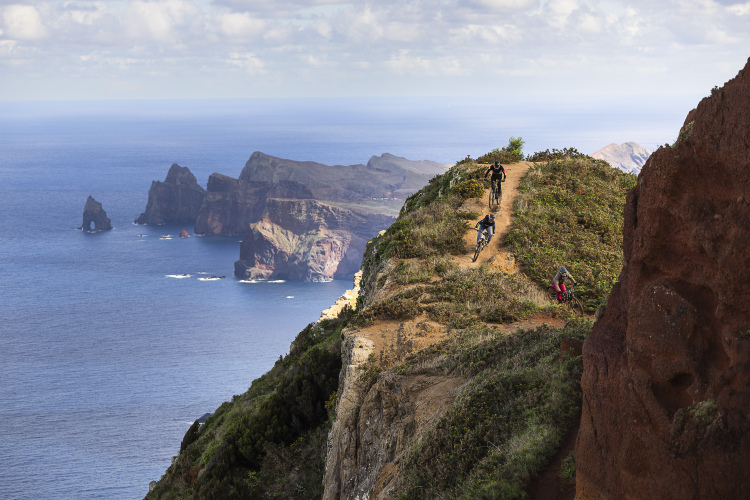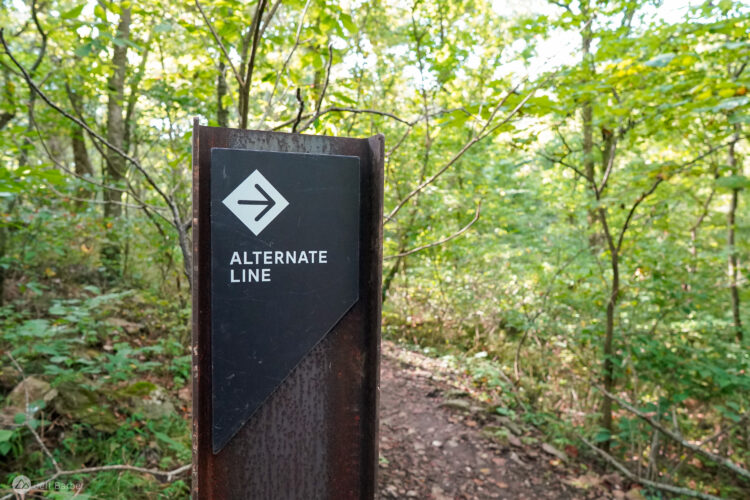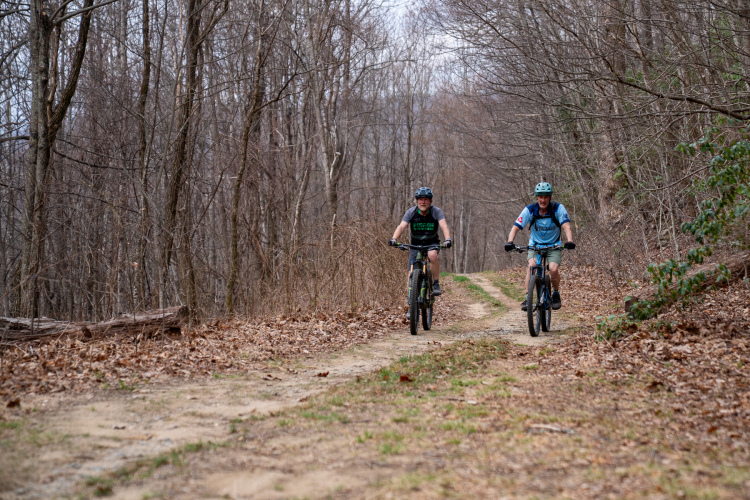
“You’re going to be the oldest guy on that shuttle.”
If I wasn’t already nervous about riding my first muddy downhill run at Windrock Bike Park in Tennessee, I was now. The man, who looked to be about my age, was relaxing in the shuttle pickup area with a few other dads who clearly weren’t riding today. On this rainy Sunday in February, a couple dozen teenagers and twenty-somethings were ripping hot laps under dark, cloudy skies and soaking up every bit of shuttle-fueled vert they could get until the truck stopped running for the day.
For perhaps the first time in my life, I was hoping the trails would be closed due to rain. But that wouldn’t happen; the trails at Windrock Bike Park hardly, if ever, close. It’s the all-weather, all-season nature of the mountain bike trails at Windrock that make this such a unique destination, one that attracts all those young, aspiring gravity athletes from across the eastern US to train on trails that Aaron Gwin says offer the closest thing to European World Cup tracks here in the United States.

Gwin and his wife Lauren purchased Windrock Bike Park from Sean Leader in October 2023, and the five-time overall World Cup Downhill champion is working to improve and expand the park.
“I spent a ton of time in the machines and working on a lot of the stuff,” Gwin told me recently. “I’m still there every week or two, kind of checking in and helping with all the design and laying the trails out. And then the boys just kind of execute when I leave.”


The bike trails at Windrock
Of course, I’m no World Cup downhiller, but I still had a blast riding at Windrock Bike Park. Technically, there is one green, beginner-rated trail at the park, but on the day I visited, the shuttle vehicle rolled right past the lower drop-off point for that trail and directly onto Midway, which feeds a mix of intermediate, advanced, and expert trails. There’s a third drop-off spot at the top of the mountain called Windmill that wasn’t open during my visit, and it’s here that riders will get the most vert and access to the full complement of black-diamond runs.

For my first run, I chose Talladega, a groomed intermediate-level run with wide, deep berms, sculpted kickers, and smooth tabletops. The trail was clearly worn in places from the countless laps that had been run in the rain all weekend, but that didn’t seem to slow anyone down. I hung back to watch the younger riders launch off some of the bigger jumps, and by the time I reached the bottom of the mountain, the shuttle was already gone; I was the only one who hadn’t made it down in time. For every shuttle run I took during my visit, I’m pretty sure everyone else managed to take two.


Drop Out is another intermediate-level run that peels off Talladega with a more natural feel. The trail is much more narrow and substitutes technical features like rocks and roots for man-made jumps. Even in wet, greasy conditions the long, extended trail runs fast and was probably my favorite of the day.

Trail One and Middle Finger are two of the most difficult trails dropping in from Midway and are clearly designed to mimic World Cup DH race courses with huge boulders leading into steep slopes and tricky turns. Walking down one of the tracks, I found an old climbing rope attached to a tree, probably left over from one of the massive DH race events held at Windrock. The mountain is so steep even the spectators need a rope to help them stay on their feet.




Reach Around is a red trail that sits somewhere in between a blue trail and a black diamond. The trail starts out pretty mellow at the top and gradually builds in intensity as the terrain gets steeper and steeper. There are some cool creeks and hollows in this zone as you wind your way down to the shuttle pickup area.
Bike park facts
- Location: 690 Hoskins Gap Rd, Oliver Springs, TN 37840
- Open Thursday through Monday
- $55 shuttle pass ($450 winter or summer season pass)
- 21 miles of trails on 1,086 acres
- 2,000ft+ vertical descent
- Website: windrockbikepark.com
Toward the bottom, I peeled off onto Golden Oak, a short double black diamond trail that looked freshly cut with dark, loamy soil and a thin web of roots just starting to poke through the dirt. Golden Oak is steep, with a couple of sharp turns that require poised body positioning to stay on the bike and set up for the next pitch. What was a white-knuckle descent for me is a dirt surfer’s paradise, a 200-foot brown wave to be threaded and shredded.

Big plans
Prior to spring 2024, Windrock visitors needed to check in at the Windrock General Store, a modern and well-stocked facility with a backwoods Buc-ees vibe. On the weekends, the massive parking lot out front is filled with toy haulers and truck trailers, making the bike park feel like a bit of an afterthought. However, since purchasing Windrock Bike Park last fall, Gwin and his team have wasted little time putting their mark on the mountain.


When I visited in February a new 2,400 square foot bike shop was coming along nicely with electricians on site roughing in the utilities and Gwin’s mechanic, James McAllister, owner of Mobile Cycle Fix, helping oversee the construction. The team was in a race to get the bike shop and new shuttle pick up area completed ahead of the Tennessee National in March, and the rain didn’t seem to be making things any easier.
“It was definitely a massive push to get it done,” Gwin said. “Jumping into that project and building a new bike shop and the road and all the infrastructure, we were working to get that all done basically in about three months.”
The team got their final building permit signed off two days before the Tennessee National enduro practice began, and the bike shop opened for the first time on the morning of practice. Windrock Bike Park hosted over 930 riders over two weekends for the event, and Gwin says the feedback from riders and spectators was overwhelmingly positive.

Earlier this month, Aaron Gwin and Windrock Bike Park announced a partnership with Kubota Tractor Corporation that includes fully equipping the park crew with a KX080-5 power utility excavator and an R640 Wheel Loader, plus other utility vehicles. “I’ve loved building trails since I was a little kid, doing little dirt jumps in the backyard,” Gwin told me. “I love building about as much as I like riding.”
It’s still early days, but Gwin says his favorite part of owning a bike park, aside from building trails, is the social aspect.
“Being able to put together [a] vision, the courses, and then see people ride and then people are really having fun […] That definitely stokes me up.”











1 Comments
Jun 2, 2024